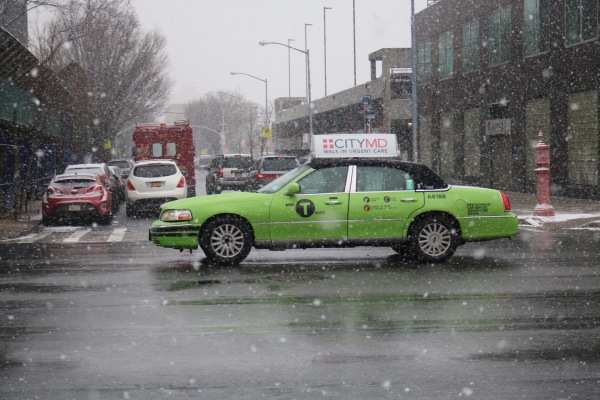By Patrick Infurna

With the rise of transportation apps like Uber and Lyft, Fordham students favor dropping a pin over hailing a yellow cab. (Owen Corrigan / The Fordham Ram)
Tourists and school trips alike scurried past Paul Lorenc, FCRH ’20, and out the door of the Metropolitan Museum of Art, hoping to beat the traffic, as if that was at all possible. Unaffected by the aura of urgency around him, Lorenc strolled down the steps of the museum without a hint of concern as to how he would get back to Fordham. While tourists and commuters of the city waved, shouted and threw their hands down in defeated exasperation, Lorenc made no effort to be noticed by cabbies, but instead silently tapped away on his phone. Lorenc had transportation home before any of the other visitors.
It does not take too long for a Fordham student to experience the frustration of traveling in Manhattan during rush hour. Attempting to find a yellow cab with its taxi sign glowing seems to be a futile search. Students at Fordham have, in large part, done away with their cab hailing frustrations by opting for car services such as Uber and Lyft. It is no surprise that Fordham University students have followed a trend that is rapidly spreading to every city in the nation. In a quickly changing world where minutes have become precious and convenience has become the hottest commodity, car service apps are changing the way the world moves.
Why do most Fordham students choose Uber or Lyft over hailing a New York City cab? Lorenc offered a simple answer, “[Uber] is just a lot easier than getting a taxi. There’s no waiting around and fighting with other people over who hailed it first.”
According to Josh Waldrum’s article on quoted.thezebra.com, the average wait time for both Uber and Lyft is just over four minutes. This, of course, comes with the certainty of a car arriving at your exact location specifically for your own use. Both Lyft and Uber are clearly more convenient for students, but what really draws most students is the affordability of car service apps over the competing yellow cab taxis. Jennifer Godfrey, FCRH ’20, summed up the simple, but key reason of Uber’s popularity on campus, “I use Uber because it’s cheaper.”
This sentiment is widely shared by students that know how trips to Manhattan can quickly add up and take a toll on their bank accounts. The knack for creating inexpensive trips to Manhattan can be a hard one to learn, but Uber and Lyft make it a bit easier.
The concrete jungle constantly bustling this way and that rightfully makes safety a top priority for university students. This concern begs the question, “Are car services such as Uber safe?” Upon stepping into an Uber service car, the driver may ask how the customer’s day was, perhaps even offer a chilled bottle of water and, above all, aims to drop off the passenger at the destination on time and in one piece. What motivates many drivers to provide exceptional service is the knowledge that each customer give them a rating out of five stars. This feature puts to rest any safety concerns Brian Ma, FCRH ’20, may have over who is at the wheel. “You can find a reliable driver through the rating system,” said Ma. “I enjoy the safer and convenient rides through Uber compared to those of taxis.”
Lyft does not underestimate the importance of integrating numerous safety measures to give its customers a sense of security. While Uber does investigate the criminal records and DMV records of its drivers, Lyft takes the safety precautions one step further. Upon applying to be a driver, Lyft’s official website requires a scheduled mentorship session that entails a 19-point vehicle inspection, which includes high standards of the basic cleanliness of the car. The mentor then steps into the car and proceeds to grade the applicant’s capability to drive and even his or her ability to hold a conversation. It may seem that Lyft’s drivers are more thoroughly tested than those of Uber, but most students use Uber simply because it is the more established brand name.
Uber and Lyft haven’t missed a trick, but will there ever be a day when the streets of New York City are void of bright yellow cabs? It is quite hard to imagine, and a bit disappointing for any tourist hoping to take a snapshot of his or her first ride in an iconic yellow checkered cab. Winnie Hu’s article in The New York Times, “Yellow Cab, Long a Fixture of City Life, Is for Many a Thing of the Past” reported that yellow cab usage has taken a substantial hit over the course of only five years.
Despite the background checks that Uber and Lyft perform, a number of Fordham students feel safer in a traditional yellow cab, perhaps in part due to the clear display of the driver’s certifications inside each cab. Conventional wisdom assumes that a traditional cab company requires more state certifications, and therefore more closely watched and controlled than car service apps. But be it for convenience, safety or thrift, the Fordham community seems to be opting for apps as the way of the future.

Sorry to hear that our city’s copious mass transportation options aren’t good enough for today’s Rams.